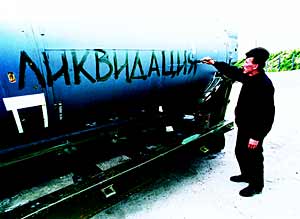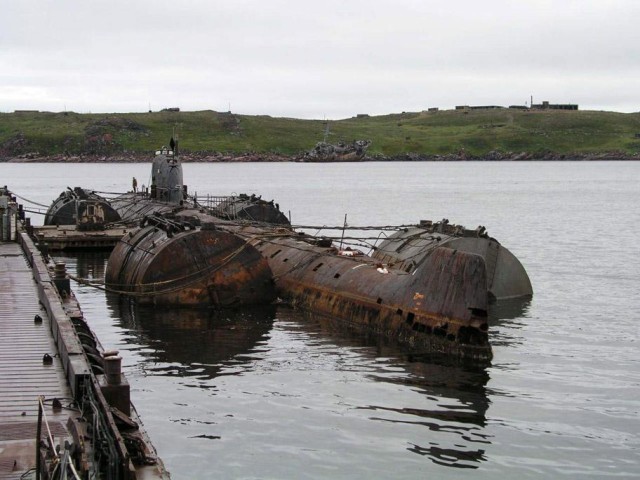
Norway’s environmental prosecutor fines Equinor a record amount following Bellona complaint
Økokrim, Norway’s authority for investigating and prosecuting economic and environmental crime, has imposed a record fine on Equinor following a comp...
News

Publish date: May 23, 2002
Written by: Charles Digges
News
OPINION
The strategic arms agreement Bush and Putin will sign also marks the fourth time Russia and America have declared their joint commitment to slash nuclear warheads to from America’s 6,000 and Russia’s 5,500 down to some 2,000 warheads each, meaning a nuclear apocalypse could only destroy the planet four or five times over.
This is touted as progress in the name of world peace and a safer planet, just as it was when Bill Clinton and Boris Yeltsin and George H.W. Bush and Yeltsin and Bush and Mikhail Gorbachev each made the same warhead-slashing agreements. And in the wake of Sept. 11, it has been hailed in by Washington as victory in the war on terror.
Washington’s response to the treaty has been heady self-congratulation. US Secretary of State Colin Powell remarked last on the treaty and the ongoing talks that would offer Russia some limited role in NATO: “We hardly have a cliché that captures this yet.”
As it stands there are so many texts now in agreement on the summit themes to be discussed this week that one wonders why the diplomats cannot just take out the old texts, dust them off, and recycle them.
In fact, on the verification part of the treaty du jour, that is exactly what they did, which is why this latest agreement is down to just three double-spaced pages, according to one high-ranking Russian official who had access to a draft of the document.
The meat of the treaty itself is only half a page long, the official said — an indication that when Bush gave Washington reporters a sneak preview of the document at a news conference two weeks ago when he read out “Russia and the US will by 2012 have 2,200 to 1,700 warheads,” he may have spoiled the ending.
By contrast, treaties like START I, signed in 1991, or START II, signed in 1993 — which in any case was never implemented — ran hundreds of pages with appendices describing in detail verification of compliance procedures, timetables for decommissioning of specific weapons systems, and precise definitions of the methods for counting warheads.
This treaty has no definitions of what warheads are or how to count them. As defence analysts Pavel Felgenhauer recently noted in his column in The Moscow Times, this treaty’s vagueness on this point means an entire nuclear submarine with 20 ballistic missiles and the capability of carrying 200 nuclear devices could be counted as one “warhead” if most of its payload is temporarily stored on land.
–>
Verification procedures are equally foggy. Washington, for its part, has promised sweeping access to Russia to verify future cuts, but again, verification procedures are not stipulated in the treaty and rely on future goodwill.
As for the decommissioning schedule, it commits neither side to anything for ten years, by which time both sides could have amassed total of some 30,000 strategic, as well as tactical nuclear weapons (about which the treaty mentions nothing) at their combined disposal, Washington Based Nation Institute Fellow Matt Bivens pointed out in a recent op-ed piece in The Moscow Times.
“Legally speaking,” said Felgenhauer, “in military arms control terms, the new treaty is nothing more than a worthless scrap of paper.”
Indeed, the treaty cost Washington almost exactly the worth of the paper it is printed on.
It managed to offer Russia the cheapest agreement at a time when securing Russia’s dilapidated nuclear infrastructure from terrorists at any cost is the most pressing security and environmental challenge Russia and the Western world face.
What Washington managed to save with such a bargain-basement bill of goods was it cherished provision to store warheads rather than fully decommission them, meaning in 10 years’ time the United States could still have some 4,600 warheads (partially deployed, partially stored for deployment), while Russia, who is committed to destroying them, will manage less than 1,200, Felgenhauer noted.
The treaty also scraps any text that would have made cuts in US offensive weapons irreversible or offered any guarantees that America’s planned missile defence shields will not threaten Russia, essentially giving Washington to do whatever it wants in the pursuit of this national security pink elephant.
But as Bivens pointed out, the billions of dollars the Pentagon spends annually on that missile shield would cover the financial burden of dismantling or securing all Russian weapons of mass destruction for good. This proposed shield – which would surgically fire missiles at missiles — has been de facto declared unworkable in recent weeks by the Pentagon, which now suggests it might take nuclear weapons to shoot down hostile missiles — a suggestion nearly tantamount to America firing nukes on itself once the rain of fallout begins to settle on the cities the missile shield was meant to defend.
However, committing money earmarked for one of America’s most cherished defence fantasies to securing the world’s most eminent threat to peace and the environment could be construed as waggish — but only in the context of Bush’s disingenuous attempts to take credit, like his father before him, for the rust on the Iron Curtain.
In fact, far from being waggish, it goes to the very heart of the matter that has marred the perpetual Cold War ending process for the last decade. Consider the following dangers to Russian-American security that this treaty makes absolutely no effort to address:
The list hardly stops here.
All of this virtually confirms that any suggestion that this summit is an advance in the world’s nuclear security is intended as nothing more than a ludicrous joke to be told between palm-pressing photo-ops of the bosom-buddy presidents.
Indeed, in the face of all of this quite open secret about the state of Russia’s nuclear security, it is a surprisingly arrogant assumption on the presidents’ behalf to think that the future of nuclear weapons development and disposal rests in their hands.
It represents the same kind of facile assumption about security that made Sept. 11 possible. But perhaps while “history is being made” and “the last nail in the coffin of the Cold War is being driven” in Moscow this week, it perhaps is impolite to intrude with such questions.
But if one thing is certain — as Russia’s non-proliferation problems and nuclear security issues continue to spiral out of control — it won’t be long before another group of Moscow and Washington leaders meet to end the Cold War yet again.

Økokrim, Norway’s authority for investigating and prosecuting economic and environmental crime, has imposed a record fine on Equinor following a comp...

Our op-ed originally appeared in The Moscow Times. For more than three decades, Russia has been burdened with the remains of the Soviet ...

The United Nation’s COP30 global climate negotiations in Belém, Brazil ended this weekend with a watered-down resolution that failed to halt deforest...

For more than a week now — beginning September 23 — the Zaporizhzhia Nuclear Power Plant (ZNPP) has remained disconnected from Ukraine’s national pow...